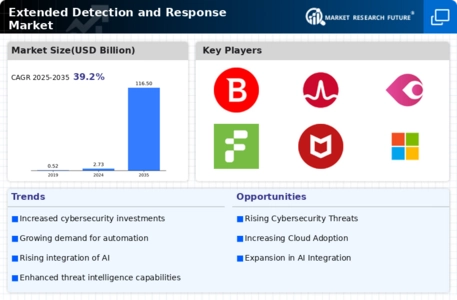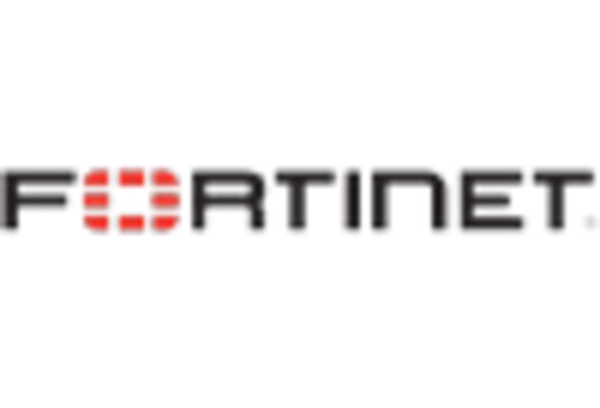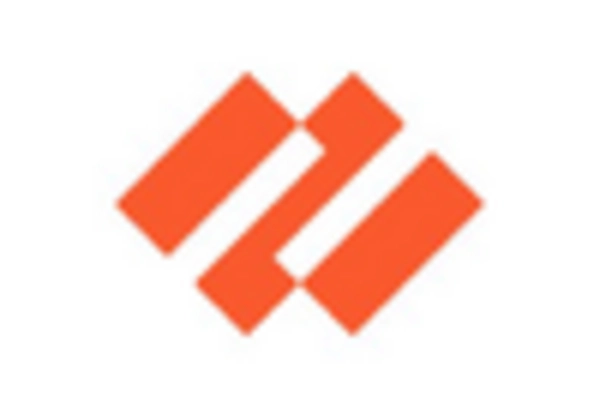-
EXECUTIVE SUMMARY
-
MARKET INTRODUCTION
-
Definition
-
Scope of the Study
- Research Objective
- Assumptions
- Limitations
-
RESEARCH METHODOLOGY
-
Overview
-
Data Mining
-
Secondary Research
-
Primary Research
- Primary Interviews and Information Gathering Process
- Breakdown of Primary Respondents
-
Forecasting Modality
-
Market Size Estimation
- Bottom-Up Approach
- Top-Down Approach
-
Data Triangulation
-
Validation
-
MARKET DYNAMICS
-
Overview
-
Drivers
-
Restraints
-
Opportunities
-
MARKET FACTOR ANALYSIS
-
Value Chain Analysis
-
Porter’s Five Forces Analysis
- Bargaining Power of Suppliers
- Bargaining Power of Buyers
- Threat of New Entrants
- Threat of Substitutes
- Intensity of Rivalry
-
COVID-19 Impact Analysis
- Market Impact Analysis
- Regional Impact
- Opportunity and Threat Analysis
-
GLOBAL EXTENDED DETECTION AND RESPONSE, BY OFFERINGS
-
Overview
-
Solutions
-
Services
-
GLOBAL EXTENDED DETECTION AND RESPONSE, BY DEPLOYMENT MODE
-
Overview
-
On-premises
-
Cloud
-
GLOBAL EXTENDED DETECTION AND RESPONSE, BY ORGANIZATION SIZE
-
Overview
-
Large Organization
-
SMEs
-
GLOBAL EXTENDED DETECTION AND RESPONSE, BY VERTICAL
-
Overview
-
BFSI
-
Government
-
Manufacturing
-
Energy and Utilities
-
Healthcare
-
Retail and eCommerce
-
IT and ITes
-
Other Verticals
-
GLOBAL EXTENDED DETECTION AND RESPONSE, BY REGION
-
Overview
-
North America
- U.S.
- Canada
-
Europe
- Germany
- France
- U.K
- Italy
- Spain
- Rest of Europe
-
Asia-Pacific
- China
- India
- Japan
- South Korea
- Australia
- Rest of Asia-Pacific
-
Rest of the World
- Middle East
- Africa
- Latin America
-
COMPETITIVE LANDSCAPE
-
Overview
-
Competitive Analysis
-
Market Share Analysis
-
Major Growth Strategy in the Global Extended Detection and Response,
-
Competitive Benchmarking
-
Leading Players in Terms of Number of Developments in the Global Extended Detection and Response,
-
Key developments and Growth Strategies
- New Products Launch/Deployment
- Merger & Acquisitions
- Joint Ventures
-
Major Players Financial Matrix
- Sales & Operating Income, 2022
- Major Players R&D Expenditure. 2022
-
COMPANY PROFILES
-
Bitdefender
- Company Overview
- Financial Overview
- Products Offered
- Key Developments
- SWOT Analysis
- Key Strategies
-
Broadcom
- Company Overview
- Financial Overview
- Products Offered
- Key Developments
- SWOT Analysis
- Key Strategies
-
Cybereason
- Company Overview
- Financial Overview
- Products Offered
- Key Developments
- SWOT Analysis
- Key Strategies
-
Cynet
- Company Overview
- Financial Overview
- Products Offered
- Key Developments
- SWOT Analysis
- Key Strategies
-
Fidelis Cybersecurity
- Company Overview
- Financial Overview
- Products Offered
- Key Developments
- SWOT Analysis
- Key Strategies
-
McAfee,LLC
- Company Overview
- Financial Overview
- Products Offered
- Key Developments
- SWOT Analysis
- Key Strategies
-
Microsoft
- Company Overview
- Financial Overview
- Products Offered
- Key Developments
- SWOT Analysis
- Key Strategies
-
Palo Alto Networks
- Company Overview
- Financial Overview
- Products Offered
- Key Developments
- SWOT Analysis
- Key Strategies
-
Red Piranha Limited
- Company Overview
- Financial Overview
- Products Offered
- Key Developments
- SWOT Analysis
- Key Strategies
-
SentinelOne
- Company Overview
- Financial Overview
- Products Offered
- Key Developments
- SWOT Analysis
- Key Strategies
-
Sophos Ltd
- Company Overview
- Financial Overview
- Products Offered
- Key Developments
- SWOT Analysis
- Key Strategies
-
APPENDIX
-
References
-
Related Reports
-
-
LIST OF TABLES
-
GLOBAL EXTENDED DETECTION AND RESPONSE, SYNOPSIS, 2018-2032
-
GLOBAL EXTENDED DETECTION AND RESPONSE, ESTIMATES & FORECAST, 2018-2032 (USD BILLION)
-
GLOBAL EXTENDED DETECTION AND RESPONSE, BY OFFERINGS, 2018-2032 (USD BILLION)
-
GLOBAL EXTENDED DETECTION AND RESPONSE, BY DEPLOYMENT MODE, 2018-2032 (USD BILLION)
-
GLOBAL EXTENDED DETECTION AND RESPONSE, BY ORGANIZATION SIZE, 2018-2032 (USD BILLION)
-
GLOBAL EXTENDED DETECTION AND RESPONSE, BY VERTICAL, 2018-2032 (USD BILLION)
-
NORTH AMERICA EXTENDED DETECTION AND RESPONSE, BY OFFERINGS, 2018-2032 (USD BILLION)
-
NORTH AMERICA EXTENDED DETECTION AND RESPONSE, BY DEPLOYMENT MODE, 2018-2032 (USD BILLION)
-
NORTH AMERICA EXTENDED DETECTION AND RESPONSE, BY ORGANIZATION SIZE, 2018-2032 (USD BILLION)
-
NORTH AMERICA EXTENDED DETECTION AND RESPONSE, BY VERTICAL, 2018-2032 (USD BILLION)
-
NORTH AMERICA EXTENDED DETECTION AND RESPONSE, BY COUNTRY, 2018-2032 (USD BILLION)
-
U.S. EXTENDED DETECTION AND RESPONSE, BY OFFERINGS, 2018-2032 (USD BILLION)
-
U.S. EXTENDED DETECTION AND RESPONSE, BY DEPLOYMENT MODE, 2018-2032 (USD BILLION)
-
U.S. EXTENDED DETECTION AND RESPONSE, BY ORGANIZATION SIZE, 2018-2032 (USD BILLION)
-
U.S. EXTENDED DETECTION AND RESPONSE, BY VERTICAL, 2018-2032 (USD BILLION)
-
CANADA EXTENDED DETECTION AND RESPONSE, BY OFFERINGS, 2018-2032 (USD BILLION)
-
CANADA EXTENDED DETECTION AND RESPONSE, BY DEPLOYMENT MODE, 2018-2032 (USD BILLION)
-
CANADA EXTENDED DETECTION AND RESPONSE, BY ORGANIZATION SIZE, 2018-2032 (USD BILLION)
-
CANADA EXTENDED DETECTION AND RESPONSE, BY VERTICAL, 2018-2032 (USD BILLION)
-
EUROPE EXTENDED DETECTION AND RESPONSE, BY OFFERINGS, 2018-2032 (USD BILLION)
-
EUROPE EXTENDED DETECTION AND RESPONSE, BY DEPLOYMENT MODE, 2018-2032 (USD BILLION)
-
EUROPE EXTENDED DETECTION AND RESPONSE, BY ORGANIZATION SIZE, 2018-2032 (USD BILLION)
-
EUROPE EXTENDED DETECTION AND RESPONSE, BY VERTICAL, 2018-2032 (USD BILLION)
-
EUROPE EXTENDED DETECTION AND RESPONSE, BY COUNTRY, 2018-2032 (USD BILLION)
-
GERMANY EXTENDED DETECTION AND RESPONSE, BY OFFERINGS, 2018-2032 (USD BILLION)
-
GERMANY EXTENDED DETECTION AND RESPONSE, BY DEPLOYMENT MODE, 2018-2032 (USD BILLION)
-
GERMANY EXTENDED DETECTION AND RESPONSE, BY ORGANIZATION SIZE, 2018-2032 (USD BILLION)
-
GERMANY EXTENDED DETECTION AND RESPONSE, BY VERTICAL, 2018-2032 (USD BILLION)
-
FRANCE EXTENDED DETECTION AND RESPONSE, BY OFFERINGS, 2018-2032 (USD BILLION)
-
FRANCE EXTENDED DETECTION AND RESPONSE, BY DEPLOYMENT MODE, 2018-2032 (USD BILLION)
-
FRANCE EXTENDED DETECTION AND RESPONSE, BY ORGANIZATION SIZE, 2018-2032 (USD BILLION)
-
FRANCE EXTENDED DETECTION AND RESPONSE, BY VERTICAL, 2018-2032 (USD BILLION)
-
ITALY EXTENDED DETECTION AND RESPONSE, BY OFFERINGS, 2018-2032 (USD BILLION)
-
ITALY EXTENDED DETECTION AND RESPONSE, BY DEPLOYMENT MODE, 2018-2032 (USD BILLION)
-
ITALY EXTENDED DETECTION AND RESPONSE, BY ORGANIZATION SIZE, 2018-2032 (USD BILLION)
-
ITALY EXTENDED DETECTION AND RESPONSE, BY VERTICAL, 2018-2032 (USD BILLION)
-
SPAIN EXTENDED DETECTION AND RESPONSE, BY OFFERINGS, 2018-2032 (USD BILLION)
-
SPAIN EXTENDED DETECTION AND RESPONSE, BY DEPLOYMENT MODE, 2018-2032 (USD BILLION)
-
SPAIN EXTENDED DETECTION AND RESPONSE, BY ORGANIZATION SIZE, 2018-2032 (USD BILLION)
-
SPAIN EXTENDED DETECTION AND RESPONSE, BY VERTICAL, 2018-2032 (USD BILLION)
-
U.K EXTENDED DETECTION AND RESPONSE, BY OFFERINGS, 2018-2032 (USD BILLION)
-
U.K EXTENDED DETECTION AND RESPONSE, BY DEPLOYMENT MODE, 2018-2032 (USD BILLION)
-
U.K EXTENDED DETECTION AND RESPONSE, BY ORGANIZATION SIZE, 2018-2032 (USD BILLION)
-
U.K EXTENDED DETECTION AND RESPONSE, BY VERTICAL, 2018-2032 (USD BILLION)
-
REST OF EUROPE EXTENDED DETECTION AND RESPONSE, BY OFFERINGS, 2018-2032 (USD BILLION)
-
REST OF EUROPE EXTENDED DETECTION AND RESPONSE, BY DEPLOYMENT MODE, 2018-2032 (USD BILLION)
-
REST OF EUROPE EXTENDED DETECTION AND RESPONSE, BY ORGANIZATION SIZE, 2018-2032 (USD BILLION)
-
REST OF EUROPE EXTENDED DETECTION AND RESPONSE, BY VERTICAL, 2018-2032 (USD BILLION)
-
ASIA PACIFIC EXTENDED DETECTION AND RESPONSE, BY OFFERINGS, 2018-2032 (USD BILLION)
-
ASIA PACIFIC EXTENDED DETECTION AND RESPONSE, BY DEPLOYMENT MODE, 2018-2032 (USD BILLION)
-
ASIA PACIFIC EXTENDED DETECTION AND RESPONSE, BY ORGANIZATION SIZE, 2018-2032 (USD BILLION)
-
ASIA PACIFIC EXTENDED DETECTION AND RESPONSE, BY VERTICAL, 2018-2032 (USD BILLION)
-
ASIA PACIFIC EXTENDED DETECTION AND RESPONSE, BY COUNTRY, 2018-2032 (USD BILLION)
-
JAPAN EXTENDED DETECTION AND RESPONSE, BY OFFERINGS, 2018-2032 (USD BILLION)
-
JAPAN EXTENDED DETECTION AND RESPONSE, BY DEPLOYMENT MODE, 2018-2032 (USD BILLION)
-
JAPAN EXTENDED DETECTION AND RESPONSE, BY ORGANIZATION SIZE, 2018-2032 (USD BILLION)
-
JAPAN EXTENDED DETECTION AND RESPONSE, BY VERTICAL, 2018-2032 (USD BILLION)
-
CHINA EXTENDED DETECTION AND RESPONSE, BY OFFERINGS, 2018-2032 (USD BILLION)
-
CHINA EXTENDED DETECTION AND RESPONSE, BY DEPLOYMENT MODE, 2018-2032 (USD BILLION)
-
CHINA EXTENDED DETECTION AND RESPONSE, BY ORGANIZATION SIZE, 2018-2032 (USD BILLION)
-
CHINA EXTENDED DETECTION AND RESPONSE, BY VERTICAL, 2018-2032 (USD BILLION)
-
INDIA EXTENDED DETECTION AND RESPONSE, BY OFFERINGS, 2018-2032 (USD BILLION)
-
INDIA EXTENDED DETECTION AND RESPONSE, BY DEPLOYMENT MODE, 2018-2032 (USD BILLION)
-
INDIA EXTENDED DETECTION AND RESPONSE, BY ORGANIZATION SIZE, 2018-2032 (USD BILLION)
-
INDIA EXTENDED DETECTION AND RESPONSE, BY VERTICAL, 2018-2032 (USD BILLION)
-
AUSTRALIA EXTENDED DETECTION AND RESPONSE, BY OFFERINGS, 2018-2032 (USD BILLION)
-
AUSTRALIA EXTENDED DETECTION AND RESPONSE, BY DEPLOYMENT MODE, 2018-2032 (USD BILLION)
-
AUSTRALIA EXTENDED DETECTION AND RESPONSE, BY ORGANIZATION SIZE, 2018-2032 (USD BILLION)
-
AUSTRALIA EXTENDED DETECTION AND RESPONSE, BY VERTICAL, 2018-2032 (USD BILLION)
-
SOUTH KOREA EXTENDED DETECTION AND RESPONSE, BY OFFERINGS, 2018-2032 (USD BILLION)
-
SOUTH KOREA EXTENDED DETECTION AND RESPONSE, BY DEPLOYMENT MODE, 2018-2032 (USD BILLION)
-
SOUTH KOREA EXTENDED DETECTION AND RESPONSE, BY ORGANIZATION SIZE, 2018-2032 (USD BILLION)
-
SOUTH KOREA EXTENDED DETECTION AND RESPONSE, BY VERTICAL, 2018-2032 (USD BILLION)
-
REST OF ASIA-PACIFIC EXTENDED DETECTION AND RESPONSE, BY OFFERINGS, 2018-2032 (USD BILLION)
-
REST OF ASIA-PACIFIC EXTENDED DETECTION AND RESPONSE, BY DEPLOYMENT MODE, 2018-2032 (USD BILLION)
-
REST OF ASIA-PACIFIC EXTENDED DETECTION AND RESPONSE, BY ORGANIZATION SIZE, 2018-2032 (USD BILLION)
-
REST OF ASIA-PACIFIC EXTENDED DETECTION AND RESPONSE, BY VERTICAL, 2018-2032 (USD BILLION)
-
REST OF WORLD EXTENDED DETECTION AND RESPONSE, BY OFFERINGS, 2018-2032 (USD BILLION)
-
REST OF WORLD EXTENDED DETECTION AND RESPONSE, BY DEPLOYMENT MODE, 2018-2032 (USD BILLION)
-
REST OF WORLD EXTENDED DETECTION AND RESPONSE, BY ORGANIZATION SIZE, 2018-2032 (USD BILLION)
-
REST OF WORLD EXTENDED DETECTION AND RESPONSE, BY VERTICAL, 2018-2032 (USD BILLION)
-
REST OF WORLD EXTENDED DETECTION AND RESPONSE, BY COUNTRY, 2018-2032 (USD BILLION)
-
MIDDLE EAST EXTENDED DETECTION AND RESPONSE, BY OFFERINGS, 2018-2032 (USD BILLION)
-
MIDDLE EAST EXTENDED DETECTION AND RESPONSE, BY DEPLOYMENT MODE, 2018-2032 (USD BILLION)
-
MIDDLE EAST EXTENDED DETECTION AND RESPONSE, BY ORGANIZATION SIZE, 2018-2032 (USD BILLION)
-
MIDDLE EAST EXTENDED DETECTION AND RESPONSE, BY VERTICAL, 2018-2032 (USD BILLION)
-
AFRICA EXTENDED DETECTION AND RESPONSE, BY OFFERINGS, 2018-2032 (USD BILLION)
-
AFRICA EXTENDED DETECTION AND RESPONSE, BY DEPLOYMENT MODE, 2018-2032 (USD BILLION)
-
AFRICA EXTENDED DETECTION AND RESPONSE, BY ORGANIZATION SIZE, 2018-2032 (USD BILLION)
-
AFRICA EXTENDED DETECTION AND RESPONSE, BY VERTICAL, 2018-2032 (USD BILLION)
-
LATIN AMERICA EXTENDED DETECTION AND RESPONSE, BY OFFERINGS, 2018-2032 (USD BILLION)
-
LATIN AMERICA EXTENDED DETECTION AND RESPONSE, BY DEPLOYMENT MODE, 2018-2032 (USD BILLION)
-
LATIN AMERICA EXTENDED DETECTION AND RESPONSE, BY ORGANIZATION SIZE, 2018-2032 (USD BILLION)
-
LATIN AMERICA EXTENDED DETECTION AND RESPONSE, BY VERTICAL, 2018-2032 (USD BILLION)
-
-
LIST OF FIGURES
-
RESEARCH PROCESS
-
MARKET STRUCTURE FOR THE GLOBAL EXTENDED DETECTION AND RESPONSE
-
MARKET DYNAMICS FOR THE GLOBAL EXTENDED DETECTION AND RESPONSE
-
GLOBAL EXTENDED DETECTION AND RESPONSE, SHARE (%), BY OFFERINGS, 2022
-
GLOBAL EXTENDED DETECTION AND RESPONSE, SHARE (%), BY DEPLOYMENT MODE, 2022
-
GLOBAL EXTENDED DETECTION AND RESPONSE, SHARE (%), BY ORGANIZATION SIZE, 2022
-
GLOBAL EXTENDED DETECTION AND RESPONSE, SHARE (%), BY VERTICAL, 2022
-
GLOBAL EXTENDED DETECTION AND RESPONSE, SHARE (%), BY REGION, 2022
-
NORTH AMERICA: EXTENDED DETECTION AND RESPONSE, SHARE (%), BY REGION, 2022
-
EUROPE: EXTENDED DETECTION AND RESPONSE, SHARE (%), BY REGION, 2022
-
ASIA-PACIFIC: EXTENDED DETECTION AND RESPONSE, SHARE (%), BY REGION, 2022
-
REST OF THE WORLD: EXTENDED DETECTION AND RESPONSE, SHARE (%), BY REGION, 2022
-
GLOBAL EXTENDED DETECTION AND RESPONSE: COMPANY SHARE ANALYSIS, 2022 (%)
-
BITDEFENDER .: FINANCIAL OVERVIEW SNAPSHOT
-
BITDEFENDER .: SWOT ANALYSIS
-
BROADCOM .: FINANCIAL OVERVIEW SNAPSHOT
-
BROADCOM .: SWOT ANALYSIS
-
CYBEREASON .: FINANCIAL OVERVIEW SNAPSHOT
-
CYBEREASON .: SWOT ANALYSIS
-
CYNET .: FINANCIAL OVERVIEW SNAPSHOT
-
CYNET .: SWOT ANALYSIS
-
FIDELIS CYBERSECURITY .: FINANCIAL OVERVIEW SNAPSHOT
-
FIDELIS CYBERSECURITY .: SWOT ANALYSIS
-
MCAFEE,LLC .: FINANCIAL OVERVIEW SNAPSHOT
-
MCAFEE,LLC .: SWOT ANALYSIS
-
MICROSOFT .: FINANCIAL OVERVIEW SNAPSHOT
-
MICROSOFT .: SWOT ANALYSIS
-
PALO ALTO NETWORKS .: FINANCIAL OVERVIEW SNAPSHOT
-
PALO ALTO NETWORKS .: SWOT ANALYSIS
-
RED PIRANHA LIMITED .: FINANCIAL OVERVIEW SNAPSHOT
-
RED PIRANHA LIMITED .: SWOT ANALYSIS
-
SENTINELONE.: FINANCIAL OVERVIEW SNAPSHOT
-
SENTINELONE.: SWOT ANALYSIS
-
SOPHOS LTD.: FINANCIAL OVERVIEW SNAPSHOT
-
SOPHOS LTD.: SWOT ANALYSIS


















Leave a Comment